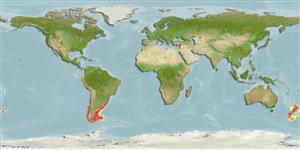Mammalia |
Carnivora |
Otariidae
Environment: milieu / climate zone / ระดับความลึก / distribution range
นิเวศวิทยา
สัตว์หน้าดินในเขตน้ำลึก. Tropical; 0°N - 90°S, 180°W - 180°E
Southeast Pacific and Southwest Atlantic: South America. Tropical to temperate.
Length at first maturity / ขนาด / Weight / Age
วัยเจริญพันธุ์: Lm ? range ? - ? cm Max length : 260 cm TL เพศผู้/กระเทย; (อ้างอิง 1394); 220 cm TL (female); น้ำหนักสูงสุดที่มีการรายงาน: 350.0 kg (อ้างอิง 1394); น้ำหนักสูงสุดที่มีการรายงาน: 350.0 kg
Found over the continental shelf and slope. Occurs in deep waters, and also venture into freshwaters in rivers and around glaciers. Feeds on many species of benthic and pelagic fishes, and invertebrates (i.e. lobster, krill, squid, octopus, and jellyfish), and occasionally penguins and young South American seals) (Ref. 1394). Preyed upon by a sevengill shark (Ref. 8910). Found over the continental shelf and slope. Occurs in deep waters, and also venture into freshwaters in rivers and around glaciers. Feeds on many species of benthic and pelagic fishes, and invertebrates (i.e. lobster, krill, squid, octopus, and jellyfish), and occasionally penguins and young South American seals) (Ref. 1394).
Life cycle and mating behavior
วัยเจริญพันธุ์ | การสืบพันธุ์ | การวางไข่ | Eggs | ความดกของไข่ | Larvae
Jefferson, T.A., S. Leatherwood and M.A. Webber 1993 FAO species Identification Guide: Marine Mammals of the World. Rome, FAO. 320 p. + 587 figures. (อ้างอิง 1394)
IUCN Red List Status
(อ้างอิง 130435: Version 2025-1)
CITES status (อ้างอิง 108899)
Not Evaluated
CMS (อ้างอิง 116361)
Threat to humans
Human uses
การประมง: การค้า
FAO - การประมง: landings, species profile | FishSource | ทะเลรอบๆเรา
เครื่องมือ
ข้อมูลเพิ่มเติม
Life cycleการสืบพันธุ์
วัยเจริญพันธุ์
ความดกของไข่
การวางไข่
Eggs
Egg development
Larvae
Human RelatedStamps, coins, misc.
แหล่งที่มาจากอินเตอร์เน็ต
Estimates based on models
Preferred temperature
(Ref.
115969): 6.3 - 15.6, mean 9.9 (based on 922 cells).
ความสามารถในการกลับคืนสู่ปกติ
ความสูง, เวลาต่ำสุดที่จะทำให้ประชากรเพิ่มขึ้นเป็น 2 เท่าใช้เวลาน้อยกว่า 15 เดือน (K=0.31-0.31).
Fishing Vulnerability
High to very high vulnerability (71 of 100).
Price category
Unknown.
